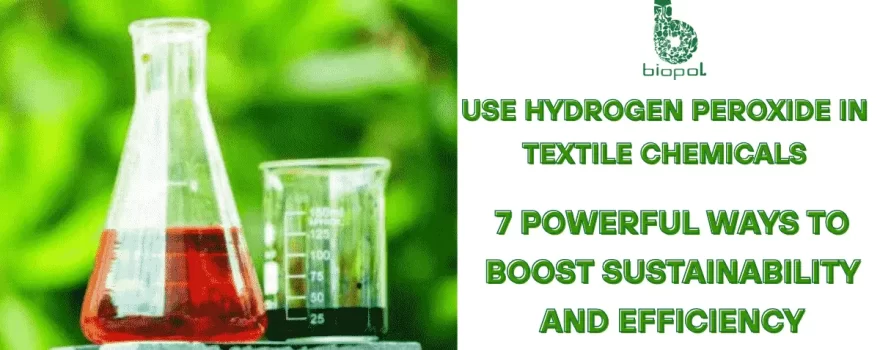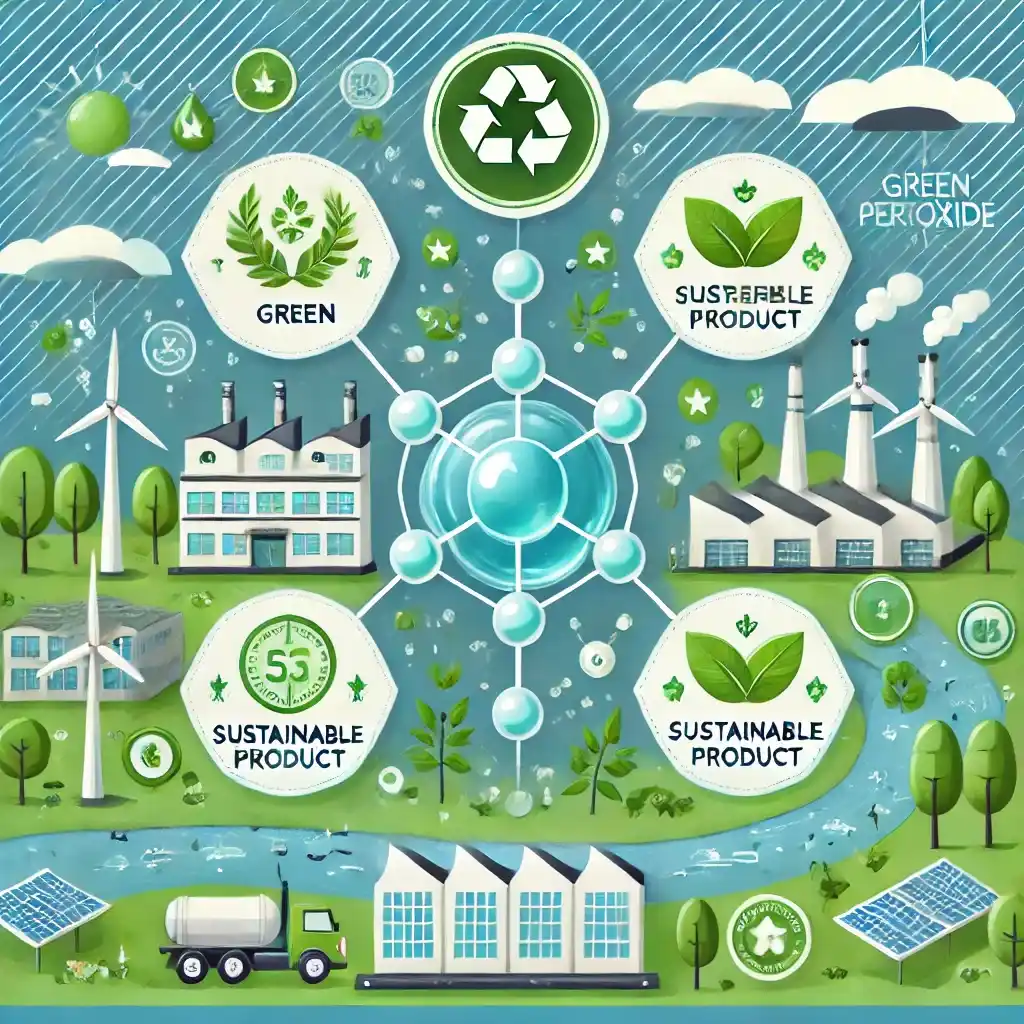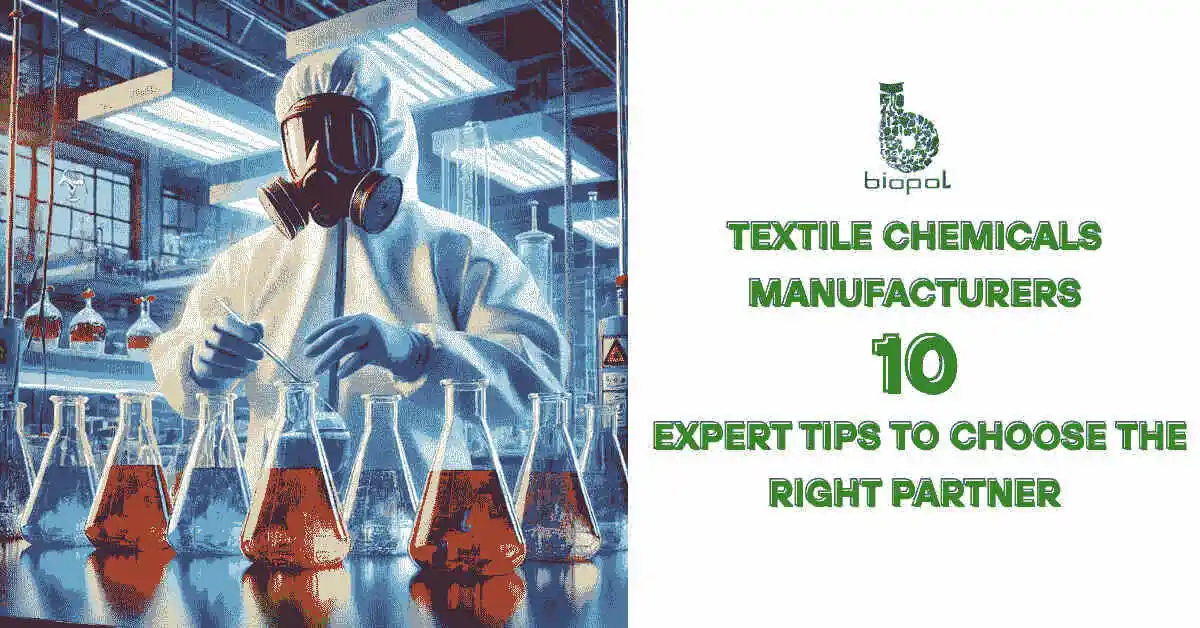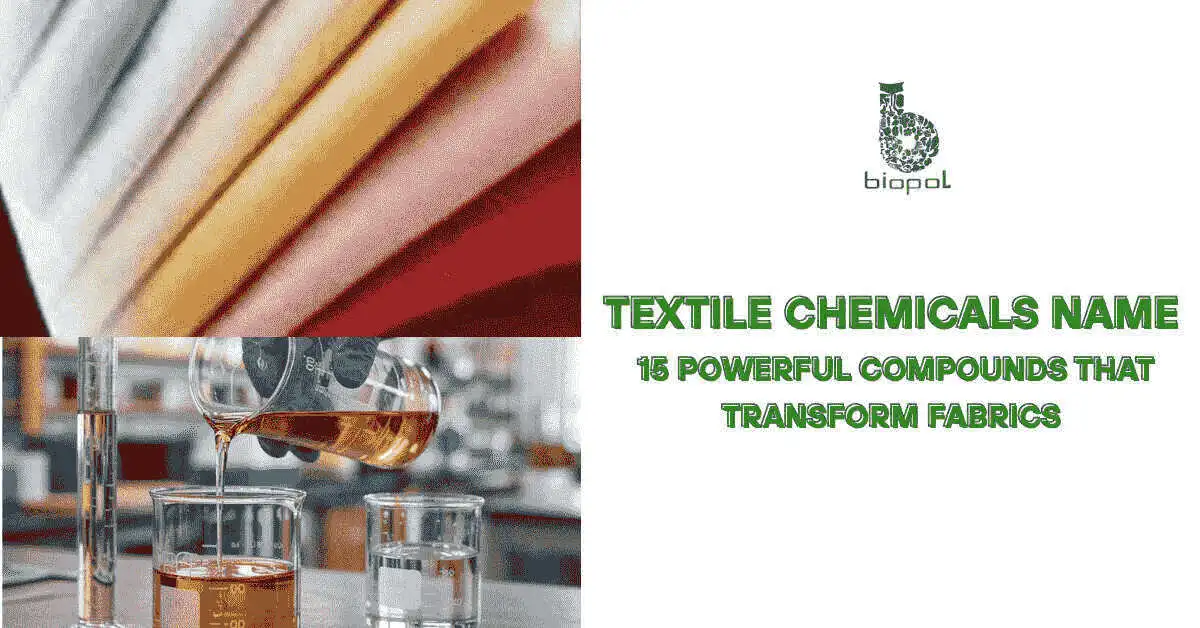
Why Use Hydrogen Peroxide in Textile Chemicals? Hydrogen peroxide is recognized as a fundamental component in the textile industry, esteemed for its environmentally friendly and efficient chemical characteristics. As a powerful oxidizing agent, it plays a key role in essential processes such as bleaching and effluent treatment, offering a sustainable alternative to traditional, environmentally taxing chemicals.
What makes hydrogen peroxide indispensable? Its byproducts—water and oxygen—perfectly align with the industry’s growing commitment to green practices. Beyond sustainability, it outperforms conventional methods by delivering brighter whites, richer colors, and superior fabric quality.
As a powerful oxidizing agent, it plays a key role in essential processes such as bleaching and effluent treatment, offering a sustainable alternative to traditional, environmentally taxing chemicals. Additionally, other eco-friendly agents like formic acid are also gaining prominence in textile processing.
Table of Contents
Use Hydrogen Peroxide in Textile Chemicals: Properties
Hydrogen peroxide (H₂O₂) is a simple yet powerful compound crucial to textile processing. Its key chemical properties include:
- Potent Oxidizing Power: Releases nascent oxygen, effectively oxidizing dyes, pigments, and impurities for vibrant, clean fabrics.
- Eco-Friendliness: Decomposes into water and oxygen, offering an environmentally safe alternative to chlorine-based agents.
- Versatility: Supports bleaching, decolorization, effluent treatment, and fiber preparation for improved dye receptivity.
- Controlled Reactivity: Stabilizers and catalysts enable precise control over its oxidizing actions, ensuring consistent results.
- Stability: Proper storage preserves its effectiveness, preventing decomposition due to light, heat, or impurities.
These properties make hydrogen peroxide indispensable for producing high-quality textiles while supporting sustainable practices.
Key Applications
We Use Hydrogen Peroxide in Textile Chemicals because it has diverse and critical applications across various stages of textile processing, demonstrating its versatility and importance in modern textile manufacturing.
| Process | Application | Benefits |
| Bleaching | – Cotton and Linen: Removes pigments and waxes for bright white fabrics. – Wool and Silk: Can be used with controlled conditions to prevent fibber damage. | Produces bright, clean fabrics while preserving fibber integrity. |
| Desizing | Combines with enzymes to remove starches and gums from woven fabrics. | Prepares fabrics for dyeing and finishing operations. |
| Scouring | Removes oils, waxes, and pectins from raw fibers, particularly cotton. | Ensures proper dye uptake and achieves uniform color. |
| Effluent Treatment | Treats textile wastewater by oxidizing and degrading organic pollutants like residual dyes and chemicals. | Minimizes environmental impact and supports regulatory compliance. |
| Other Applications | – Dyeing: Enhances colorfastness and brightness. – Fabric Preparation: Prepares fabrics for mercerization and resin treatment | Improves dye quality and prepares textiles for specialized finishes. |
Benefits
We Use Hydrogen Peroxide in Textile Chemicals as it offers numerous advantages over traditional textile chemicals, making it a preferred choice for environmentally conscious and cost-effective textile production.
- Environmental: Eco-friendly, decomposes into water and oxygen, reduces pollution, and limits VOC emissions.
- Economic: Cost-effective, lowers waste disposal costs, and enhances product quality with brighter whites and vibrant colors.
- Efficiency: Speeds up processes, preserves fiber strength, and offers versatility for bleaching, dyeing, and wastewater treatment.
Hydrogen peroxide drives sustainable, efficient, and high-quality textile production.
Hydrogen Peroxide in Textile Bleaching
We Use Hydrogen Peroxide in Textile Chemicals because revolutionizes textile bleaching by combining exceptional fabric quality with environmental responsibility.
- Achieves Optimal Brightness: Removes impurities like pigments and waxes, delivering dazzling white fabrics without the yellowish tint left by chlorine-based bleaches.
- Eco-Friendly: Decomposes into water and oxygen, eliminating harmful byproducts and supporting sustainable practices.
- Enhances Fabric Appeal: Improves brightness and ensures vibrant, long-lasting colors for dyed fabrics.
- Sustainable Future: Empowers manufacturers to produce high-quality, eco-conscious textiles.
Hydrogen peroxide is the cornerstone of modern, sustainable textile bleaching.
Role in Textile Pretreatment Processes
To Use Hydrogen Peroxide in Textile Chemicals for pre-treatment helps play a crucial role in preparing textiles for subsequent dyeing and finishing processes. These pretreatment steps are essential to ensure optimal dye uptake, even color distribution, and improved fabric quality.
| Key Roles in Pretreatment | Description | Benefits |
| Scouring | Removes waxes, oils, and pectins from raw fibers, especially cotton. | Enhances dye receptivity and improves fabric quality. |
| Desizing | Used with enzymes to eliminate sizing agents like starches and gums from woven yarns. | Ensures uniform dye penetration and prevents uneven color distribution |
| Bleaching | Eliminates natural pigments and impurities, preparing fabrics for dyeing. | Provides a clean, receptive surface for dye adherence. |
| Benefits of Hydrogen Peroxide in Pretreatment | Details |
| Improved Dye Uptake | Ensures uniform color distribution and vibrant shades by removing impurities. |
| Enhanced Fabric Quality | Leads to stronger, softer, and higher-quality fabrics through thorough cleaning and preparation. |
| Environmental Friendliness | Reduces harmful chemical release, supporting sustainable and eco-friendly textile processes. |
Safety and Handling Guidelines
- Storage:
- Store in a cool, dry, ventilated area, away from sunlight, heat, and incompatible materials.
- Use original, sealed, compatible containers (e.g., polyethylene, stainless steel) to prevent leaks and contamination.
- Store separately from acids, alkalis, and combustibles.
- Clearly label containers with concentration, hazard warnings, and handling instructions.
- Maintain accurate inventory records.
- Regularly check for signs of degradation (e.g., gas evolution, discoloration).
- Usage:
- Always wear appropriate PPE (goggles, gloves, long-sleeved clothing, closed-toe shoes).
- Ensure adequate ventilation in usage areas.
- Have a spill response plan with neutralizing agents (e.g., sodium bisulfite solution) readily available.
- Establish and follow clear emergency procedures for spills, leaks, and accidental contact.
- Provide comprehensive training to all personnel involved in handling and using hydrogen peroxide on safe handling practices, emergency procedures, and the potential hazards.
- Regularly check and maintain equipment used for handling and storage.
- Avoid contact with skin, eyes, and mucous membranes. In case of contact, immediately flush the affected area with plenty of water.
- Disposal:
- Neutralize any residual hydrogen peroxide before disposal according to local regulations and safety guidelines.
- Ensure that any wastewater containing hydrogen peroxide is properly treated to remove any residual chemicals before discharge.
- Adhere to all local, state, and federal regulations regarding the storage, handling, and disposal for a fair Use Hydrogen Peroxide in Textile Chemicals.
- Consult with a waste disposal professional to ensure proper and legal disposal of any waste containing hydrogen peroxide.
By following these comprehensive guidelines, textile manufacturers can minimize the risks associated with hydrogen peroxide and ensure a safe and responsible working environment.
Challenges and Limitations
- Compatibility Issues: Residual peroxide can interfere with dyeing, especially reactive dyes, requiring thorough rinsing. It may also react with reducing agents and metal salts, causing unexpected reactions or fabric damage.
- Operational Challenges: Peroxide solutions decompose with impurities, heat, or light, demanding careful storage and handling. It poses safety risks due to its strong oxidizing nature and requires specialized equipment for handling and precise process control for consistent results.
- Environmental Considerations: Wastewater from bleaching may still require treatment to remove residual chemicals before discharge.
- Cost: While often economical, costs can vary based on concentration, application, and additional equipment or chemicals needed.
By addressing these challenges through innovation and optimization, the textile industry can maximize the benefits of hydrogen peroxide while maintaining sustainable and efficient production.
Innovations and Emerging Trends for Use Hydrogen Peroxide in Textile Chemicals
Hydrogen peroxide is a key chemical in textile processing, offering eco-friendly bleaching and other benefits.
Key Uses:
- Bleaching: Whitens fabrics like cotton and linen, replacing harmful chlorine.
- Pretreatment: Removes impurities from fibers, improving dye uptake.
- Effluent Treatment: Degrades pollutants in textile wastewater.
Advantages:
- Environmentally Friendly: Decomposes into water and oxygen, minimizing pollution.
- Improved Quality: Produces brighter whites and vibrant colors.
- Cost-Effective: Can reduce chemical usage and improve process efficiency.
Challenges:
- Compatibility: Can react with other chemicals, affecting dyeing and fabric quality.
- Stability: Solutions can decompose, requiring careful storage and handling.
- Safety: Requires proper handling and PPE to avoid hazards.
Innovations:
- Stabilized formulations: Improve storage and reduce waste.
- Enzyme-assisted bleaching: Enhances efficiency and reduces environmental impact.
- Closed-loop systems: Minimize water usage and recycle process water.
Hydrogen peroxide plays a crucial role in sustainable textile manufacturing, with ongoing research and development further enhancing its applications and minimizing its environmental impact.
Key Considerations to Use Hydrogen Peroxide in Textile Chemicals
- Fabric Type: The choice of bleaching agent depends on the type of fabric being processed.
- Environmental Regulations: Local regulations regarding chemical usage and wastewater discharge will significantly influence the choice of bleaching agent.
- Cost-Effectiveness: The overall cost of the bleaching process, including chemical costs, equipment costs, and energy consumption, must be considered.
- Case Study 1: A Leading Denim Manufacturer
- Challenge: Facing pressure to reduce environmental impact and improve product quality. Traditional chlorine bleaching was causing significant pollution and impacting fabric strength.
- Solution: Implemented a hydrogen peroxide-based bleaching process.
- Results: Achieved brighter whites and more consistent color outcomes. Reduced chemical usage and wastewater treatment costs. Improved fabric strength and durability. Enhanced brand image due to the use of eco-friendly practices.
- Case Study 2: A Mid-sized Organic Cotton Producer
- Challenge: Required a bleaching process that aligned with their organic and sustainable certification standards. Chlorine-based options were not acceptable.
- Solution: Adopted a hydrogen peroxide bleaching process with a focus on minimizing chemical usage and optimizing process efficiency.
- Results: Successfully met organic certification requirements. Reduced water consumption and energy usage. Improved overall environmental performance.
- Case Study 3: A Large-Scale Textile Mill
- Challenge: Seeking to improve the quality of their bleached cotton while minimizing environmental impact and production costs.
- Solution: Invested in advanced hydrogen peroxide bleaching technology, including automated process control and optimized chemical dosing.
- Results: Achieved significant improvements in fabric whiteness and consistency. Reduced chemical usage and wastewater treatment costs. Increased production efficiency and reduced downtime.
Key Takeaways from these Case Studies:
- Successful implementation of hydrogen peroxide often involves a combination of optimized processes, advanced technology, and a strong focus on environmental sustainability.
- By carefully considering factors like chemical usage, water consumption, energy usage, and waste generation, textile manufacturers can achieve significant environmental and economic benefits.
- These case studies demonstrate that hydrogen peroxide can be a valuable tool for achieving both environmental sustainability and improved product quality in the textile industry.
Environmental Impact

Hydrogen peroxide is a sustainable choice for textile processing, offering minimal environmental impact compared to chlorine-based alternatives.
- Key Environmental Advantages:
- Biodegradability: Breaks down into water and oxygen, leaving no harmful residues.
- Reduced Pollution: Prevents chlorinated compound emissions, improving air and water quality.
- Waste Minimization: Reduces hazardous waste generation and simplifies waste treatment.
- Waste Management:
- Proper disposal and wastewater treatment are essential to remove residual chemicals and meet regulations.
- Closed-loop systems can further minimize water usage and recycle process water, reducing environmental impact.
- Green Certifications:
- GOTS: Promotes environmentally and socially responsible processes.
- OEKO-TEX: Ensures textiles are free from harmful substances.
- Blue Sign: Evaluates production chains for environmental and social sustainability.
- Promoting Sustainability:
- Conduct Life Cycle Assessments (LCAs) to optimize environmental performance.
- Continuously improve processes to reduce waste and enhance efficiency.
By adopting hydrogen peroxide and sustainable practices, the textile industry can reduce its ecological footprint and support a greener future.
Cost Analysis
To Use Hydrogen Peroxide in Textile Chemicals can be a cost-effective option for textile processing when considering the entire lifecycle.
Cost Factors
- Chemical Costs:
- Initial Investment: Hydrogen peroxide can have a higher initial cost compared to some traditional chlorine-based bleaches.
- Usage Rates: Optimized processes can minimize chemical usage, reducing overall costs.
- Equipment Costs:
- Investment: May require investment in specific equipment for handling and storing hydrogen peroxide.
- Maintenance: Regular maintenance of equipment is essential to ensure optimal performance and minimize downtime.
- Labor Costs:
- Training: Requires training of personnel on safe handling and usage of hydrogen peroxide.
- Operational Costs: Skilled labor may be required for process control and monitoring.
- Wastewater Treatment:
- Reduced Costs: Lower wastewater treatment costs due to the reduced generation of hazardous byproducts.
- Improved Efficiency: Optimized processes can minimize wastewater volume, further reducing treatment costs.
- Energy Costs:
- Efficiency Gains: Hydrogen peroxide-based processes can sometimes be more energy-efficient than traditional methods, leading to lower energy costs.
- Cost-Effectiveness Factors:
- Reduced Rejects: Improved fabric quality and consistency can lead to fewer rejects and rework, significantly impacting overall costs.
- Increased Productivity: Optimized processes can increase production throughput, leading to higher output and improved profitability.
- Enhanced Product Value: Brighter whites and more vibrant colors can enhance the value of the final product, allowing for higher selling prices.
- Brand Image: Using eco-friendly chemicals like hydrogen peroxide can enhance the brand image and attract environmentally conscious consumers.
Key Considerations
- Life Cycle Cost Analysis (LCA): Conducting a comprehensive LCA can provide a holistic view of the costs associated with hydrogen peroxide usage, considering all stages of the textile production process.
- Process Optimization: Continuous improvement of processes, including optimizing chemical usage, minimizing water consumption, and maximizing energy efficiency, is crucial for maximizing cost-effectiveness, to continue to Use Hydrogen Peroxide in Textile Chemicals.
Conclusion
Hydrogen peroxide is set to become a cornerstone of eco-conscious textile production, thanks to its environmental benefits and ongoing innovations.
- Sustainability Driver: Its minimal environmental impact supports ethical and sustainable manufacturing.
- Innovation Catalyst: Advancements like stabilized solutions and enzyme-assisted bleaching enhance performance and reduce ecological footprints.
- Key to Circularity: Integrating hydrogen peroxide into closed-loop systems aligns with circular economy principles, optimizing resource use.
By prioritizing innovation and sustainability, it will help Use Hydrogen Peroxide in Textile Chemicals to drive the textile industry toward producing high-quality, eco-friendly fabrics that meet both consumer and environmental demands.
FAQs
What are the environmental benefits of using hydrogen peroxide over chlorine in textile bleaching?
- Hydrogen peroxide decomposes into water and oxygen, leaving no harmful byproducts.
- Chlorine generates harmful chlorinated compounds that pollute water and air.
- Hydrogen peroxide reduces the release of volatile organic compounds (VOCs).
Can hydrogen peroxide damage textile fibers?
- While generally safe, improper use of hydrogen peroxide can damage certain fibers, especially at high concentrations or with inadequate temperature control.
- Careful process control and adherence to recommended usage guidelines are crucial.
How does hydrogen peroxide improve the quality of textile products?
- Brighter Whites: Produces whiter and brighter fabrics, enhancing their visual appeal.
- Vibrant Colors: Improves the brightness and vibrancy of dyed fabrics.
- Improved Strength: Can help maintain fiber strength and integrity, leading to more durable fabrics.
What are the challenges of using hydrogen peroxide in textile processing?
- Stability: Hydrogen peroxide solutions can decompose over time, requiring careful storage and handling.
- Compatibility: Can react with certain dyes and other chemicals, impacting the dyeing process.
- Safety: Requires proper handling and PPE to avoid skin and eye irritation.
How can I ensure the safe and effective use of hydrogen peroxide in my textile operations?
- Proper Training: Train personnel on safe handling, storage, and usage procedures.
- Regular Maintenance: Ensure proper maintenance of equipment used for handling and storing hydrogen peroxide.
- Risk Assessment: Conduct regular risk assessments to identify and mitigate potential hazards.
- Adhere to Regulations: Comply with all relevant environmental and safety regulations.
What are some emerging trends in hydrogen peroxide use in the textile industry?
- Enzyme-assisted bleaching: Combining hydrogen peroxide with enzymes for enhanced efficiency and reduced environmental impact.
- Closed-loop systems: Minimizing water usage and recycling process water to reduce environmental footprint.
- Nano-enabled formulations: Improving reactivity and reducing usage through nanotechnology.
How can I determine if hydrogen peroxide is the right choice for my specific textile application?
- Consult with experts: Seek advice from chemical suppliers, textile machinery manufacturers, and environmental consultants.
- Conduct pilot trials: Conduct small-scale trials to evaluate the performance and cost-effectiveness of hydrogen peroxide in your specific application.
- Consider environmental and economic factors: Evaluate the overall environmental and economic impact of hydrogen peroxide compared to alternative bleaching agents.
What is the use of hydrogen peroxide in the textile industry?
Hydrogen peroxide is extensively utilized in the textile sector for multiple applications, such as bleaching, cleaning, and sanitization. It helps in the bleaching of fabrics, especially cotton, by breaking down color pigments and stains. It is also used for the de-sizing process, which removes starch or other substances from the fabric to make it smoother and ready for further processing.
What is the use of hydrogen peroxide in the chemical industry?
In the chemical industry, hydrogen peroxide is used as a powerful oxidizing agent in various applications such as the production of peracetic acid, in wastewater treatment, and in the manufacturing of certain chemicals like epoxy resins. It is also used in the production of detergents, disinfectants, and as a bleaching agent in paper and pulp industries.
Is hydrogen peroxide safe for fabric?
When used properly and in appropriate concentrations, hydrogen peroxide is generally safe for fabrics, particularly cotton. It helps in bleaching and stain removal without damaging the fibers. However, excessive use or high concentrations of hydrogen peroxide can weaken the fabric and cause discoloration or damage over time. It is essential to follow proper usage guidelines and dilute the solution as needed to avoid fabric damage.
Also Read: Textile Chemicals: The Secret Sauce Behind Your Clothes

